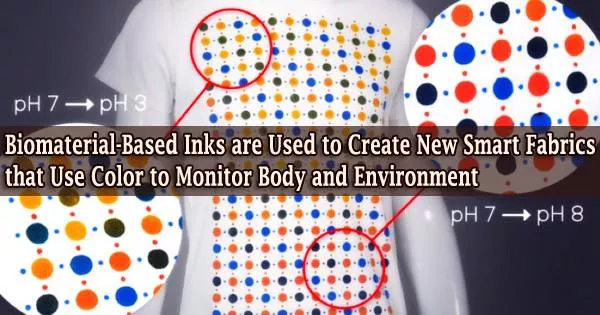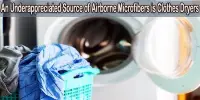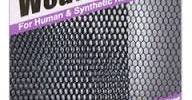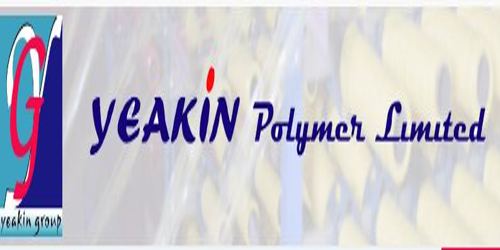The School of Engineering at Tufts University has created biomaterial-based inks that alter color in response to chemicals emitted from the body or the environment (such as sweat and possibly other biofluids) in order to measure their concentration.
The inks can be screen printed in intricate patterns and at high resolution into textiles like clothing, shoes, or even face masks to produce a precise map of human response or exposure.
The advancement in wearable sensing, described in Advanced Materials, might use regular clothing and uniforms to concurrently detect and quantify a wide range of biological states, chemicals, and, conceivably, pathogens over the surface of the body.
“The use of novel bioactive inks with the very common method of screen printing opens up promising opportunities for the mass-production of soft, wearable fabrics with large numbers of sensors that could be applied to detect a range of conditions,” said Fiorenzo Omenetto, corresponding author and the Frank C. Doble Professor of Engineering at Tufts’ School of Engineering.
“The fabrics can end up in uniforms for the workplace, sports clothing, or even on furniture and architectural structures.”
The monitoring of human performance and health has generated significant interest in wearable sensing technology. Numerous similar devices, which incorporate electronics into wearable patches, wristbands, and other configurations, have been developed to track specific or general physiological data like blood sugar or heart rate.
The study from Tufts University uses a distinct, complementary method: non-electronic, colorimetric detection of a theoretically very large number of analytes utilizing sensor garments that can be dispersed to cover extremely wide areas, ranging from a patch to the complete body and beyond.
Biologically activated silk-based inks are the key components that enable the sensing clothing. By incorporating different “reporter” molecules, such as pH-sensitive indicators or enzymes like lactate oxidase to show amounts of lactate in sweat, the soluble silk substrate in these ink formulations can be changed.
The former may be a sign of skin health or dehydration, whilst the latter may reveal the wearer’s level of weariness. The adaptability of the silk fibroin protein allows for the creation of numerous additional derivatives of the inks through modification with active molecules including chemically reactive colors, enzymes, antibodies, and more.
The use of novel bioactive inks with the very common method of screen printing opens up promising opportunities for the mass-production of soft, wearable fabrics with large numbers of sensors that could be applied to detect a range of conditions. The fabrics can end up in uniforms for the workplace, sports clothing, or even on furniture and architectural structures.
Fiorenzo Omenetto
While the reporter molecules might be unstable on their own, when included into the silk fibroin in the ink formulation, they can become shelf-stable. The inks are created using a plasticizer (glycerol) and a thickening (sodium alginate) for screen printing applications.
The screen-printable bio-inks may be applied to a variety of materials, including wood, plastic, and paper, to create designs that range in size from hundreds of microns to tens of meters. They can also be utilized like any other ink created for screen printing.
While the color changes caused by the inks can serve as a visual clue to the presence or absence of an analyte, using camera image analysis to scan the clothing or other material can yield more accurate data on amount and high resolution, sub-millimeter mapping.
The innovation builds on prior work by the same researchers who created bioactive silk inks designed for inkjet printing to make petri dishes, paper sensors, and lab gloves that may visually show bacterial contamination.
“The screen printing approach provides the equivalent of having a large, multiplexed arrangement of sensors covering extensive areas of the body, if worn as a garment, or even on large surfaces such as room interiors,” said Giusy Matzeu, research assistant professor of biomedical engineering at Tufts School of Engineering and first author of the paper.
“Coupled with image analysis, we can obtain a high resolution mapof color reactions over a large area and gain more insight on overall physiological or environmental state. In theory, we could extend this method to track air quality, or support environmental monitoring for epidemiology.”
The fact that the method uses common printing techniques also opens up avenues in creative applications something explored by Laia Mogas-Soldevila, architect and recent PhD graduate at Tufts in Omenetto’s SilkLab. Mogas-Soldevila has helped to create beautiful tapestries, displaying them in museums across the United States and Europe.
Visitors can spray various non-toxic chemicals over the fabric in the interactive exhibits to see how the patterns change.
“This is really a great example of how art and engineering can gain from and inspire each other,” said Mogas-Soldevila. “The engineered inks open up a new dimension in responsive, interactive tapestries and surfaces, while the 1,000-year old art of screen printing has provided a foundation well suited to the need for a modern high resolution, wearable sensing surface.”
The research was supported by grants from the U.S. Army Natick Soldier Research, Development and Engineering Center (W911QY-15-2-0001), the Office of Naval Research (N00014-19-1-2399), and a gift from the Stavros Niarchos Foundation (SNF).
















